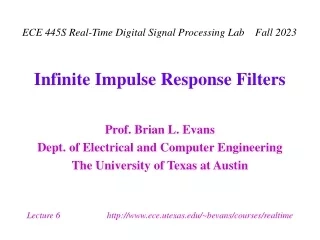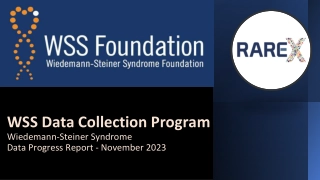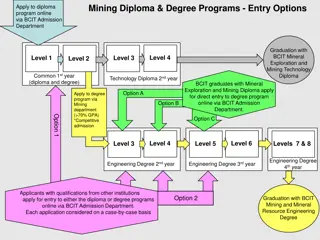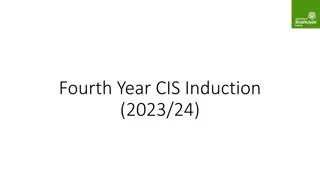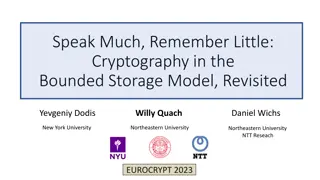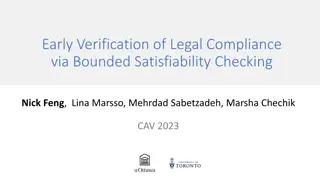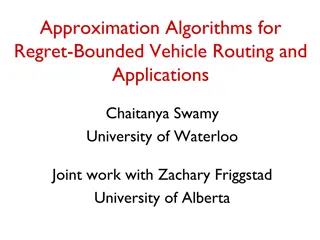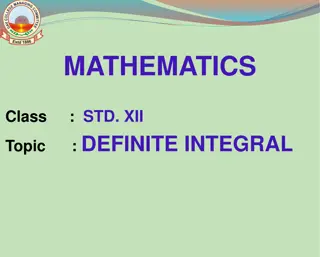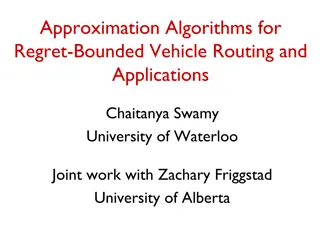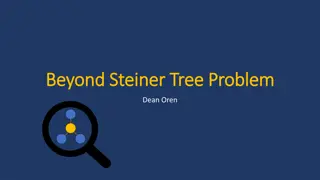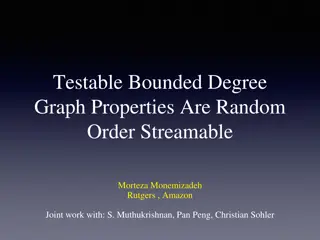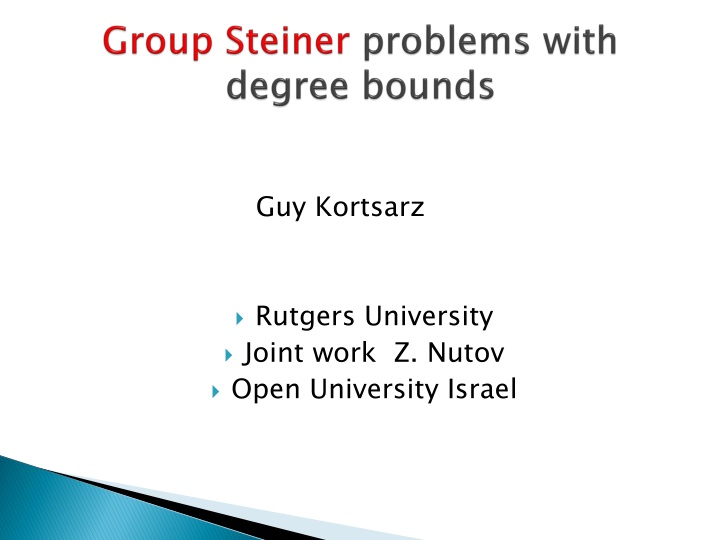
Group Steiner Tree Problem: Approximation Methods and Degree Bounds
The Group Steiner Tree Problem involves finding a tree rooted at a central vertex that connects transistors located at different ports in a VLSI circuit. Various approximation methods and degree bounds have been explored, with a focus on low degrees for efficient layout and routing. Known approximations, such as the Directed Steiner Tree Problem and individual degree bounds, are discussed alongside challenges in respecting degrees during reductions. Additionally, insights into the ratio for the Minimum Max Degree Group Steiner on Bounded Tree Width graphs are shared, shedding light on complexities in achieving optimal solutions without explicit degree constraints.
Download Presentation

Please find below an Image/Link to download the presentation.
The content on the website is provided AS IS for your information and personal use only. It may not be sold, licensed, or shared on other websites without obtaining consent from the author. If you encounter any issues during the download, it is possible that the publisher has removed the file from their server.
You are allowed to download the files provided on this website for personal or commercial use, subject to the condition that they are used lawfully. All files are the property of their respective owners.
The content on the website is provided AS IS for your information and personal use only. It may not be sold, licensed, or shared on other websites without obtaining consent from the author.
E N D
Presentation Transcript
Guy Kortsarz Rutgers University Joint work Z. Nutov Open University Israel
Given a graph G(V,E) with edge costs c(e) and a root r. A group is a subset giof V. Say: k groups g1, .,gk Let the maximum size of a group is N. A solution is a Tree T(V ,E ), rooted at r so that contains at least one vertex of every gi
The motivation came from VLSI. Transistors need to be connected by a tree to a central vertex r. Every transistor can be located at different ports (the group). Once you choose the port per transistor then you need to choose a tree and connect to r. In practice low degree are very important for layout and routings. Maybe more important than costs.
g2 g3 g5 g4,g5 g1,g2, g3 4 8 8 4 7 4 g1,g4 6 3 4 14 2 R
g2 g3 g5 4 g1,g4 3 1 2 R
3 3 2 10 1 1 1 1 1 1 1
3 3 2 1 1 1 1 1
Fakcharoenpho Rao and Talwar reduction does not respect degrees. The reductions of Racke do not work. Only known approximation: For the Directed Steiner Tree Problem: (O(log2n),O(log2 n)) bicriteria in qusi-poly time. Due to Guo, Kortsarz, Laekhanukit, Li, Vaz and Xian. Manuscript
For trees (O(log2 n),O(log2 n)) and individual degree bounds dv (O(log2 n) O(log3 n)) was known but not published. A. K. A folklore. O(log3 n) ratio for the Minimum Max Degree Group Steiner on Bounded Tree Width graphs.
Let ev be the parent edge of v. Let u1,u2up be the children of v in the tree. ei =(v, ui) I x(ei) x(ev)*dv is a valid inequality. If x(ev)=0 then all x(ei) must be zero for all i. If x(ev)=1 then I x(ei) dv is a valid inequality.
However if no degree bounds: O(ntw(G)) time O(log2 n) ratio for Minimum Cost Group Steiner on BTW graphs. Due to Chalermsook, Das, Laekhanukit and Vaz Does not use FRT. We deal with no cost case. The goal: minimize the maximum degree on BTW graphs.
2 1
Make sure any parent-child have an least one edge. Select to the separator an extra vertex that has an edge to a vertex in the parent separator. Make all separators connected adding O(log n) additive factor on degrees. Replace any backward edge in the optimum uses by the path in the tree. Prove it is O(log n d*) additive degree for every vertex.
We can get from any vertex in a set to any other vertex in another set (separators connected and at least one edge for any parent child). Therefore we contract the separators getting a DFS tree. O(k) multiplication of the degrees in the optimum. Any path in the tree corresponds to a path in the graph.
Let T(Z) be the tree rooted by a separator Z. Fix a vertex u in Z. Add in T(Z) the paths from all other vertices in Z-u to u in T(Z) This adds O(log n) additive ratio.
A vertex is affected from O(log n) separators, one per every level. This follows from the DFS structure of the tree. We add k+2 paths that may affect a vertex at every level. The increase of degree is by at most 2(k+2) per level. Therefore an additive O(log n) additive number of edges per vertex. Its very important we connected downward.
Contract the separators to a vertex. Remove self loops and parallel edges. We got a standard DFS tree with backward edges. So why did we not start with a DFS tree? Because in our tree we have height O(log n). Take OPT and replace each backward edge uv by the path in the tree between uv in the tree. What is the affect on the degrees?
In the optimum, if degres are at most d* then there will be at most (k+1) d* backward edges per separator. Replacing them with paths gives at most 2 (k+1) d* additive increase in the degree of many vertices. The total increase is an O(log n) d* additive increase in the degrees for any specific vertex. We transformed the OUTPUT into a tree.
Since we removed all backward edges, the new solution is a tree. With additive Penalty O(log n) d* increase in the degree. Thus the solution will be a subtree of T . Namely the tree resulting by removing backward edges. Thus we can change the INPUT to T and use our algorithm for trees.
Recently (O(log2n) O(log n)) for minimum degree Group Steiner on trees. Optimal! Gives O(log2 n) ratio for Minimum MAX Degree for Group Steiner on BTW graphs. The case of BTW with degree bounds and cost is not known to admit any polylog ratio in polynomial time(!). Open problem. More results omitted due to time limitation.

